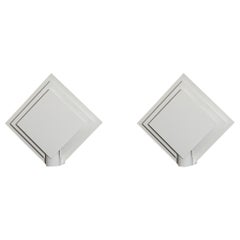Arnout Visser
Recent Sales
Vintage 1980s Dutch Post-Modern Wall Lights and Sconces
Steel
A Close Look at post-modern Furniture
Postmodern design was a short-lived movement that manifested itself chiefly in Italy and the United States in the early 1980s. The characteristics of vintage postmodern furniture and other postmodern objects and decor for the home included loud-patterned, usually plastic surfaces; strange proportions, vibrant colors and weird angles; and a vague-at-best relationship between form and function.
ORIGINS OF POSTMODERN FURNITURE DESIGN
- Emerges during the 1960s; popularity explodes during the ’80s
- A reaction to prevailing conventions of modernism by mainly American architects
- Architect Robert Venturi critiques modern architecture in his Complexity and Contradiction in Architecture (1966)
- Theorist Charles Jencks, who championed architecture filled with allusions and cultural references, writes The Language of Post-Modern Architecture (1977)
- Italian design collective the Memphis Group, also known as Memphis Milano, meets for the first time (1980)
- Memphis collective debuts more than 50 objects and furnishings at Salone del Milano (1981)
- Interest in style declines, minimalism gains steam
CHARACTERISTICS OF POSTMODERN FURNITURE DESIGN
- Dizzying graphic patterns and an emphasis on loud, off-the-wall colors
- Use of plastic and laminates, glass, metal and marble; lacquered and painted wood
- Unconventional proportions and abundant ornamentation
- Playful nods to Art Deco and Pop art
POSTMODERN FURNITURE DESIGNERS TO KNOW
- Ettore Sottsass
- Robert Venturi
- Alessandro Mendini
- Michele de Lucchi
- Michael Graves
- Nathalie du Pasquier
VINTAGE POSTMODERN FURNITURE ON 1STDIBS
Critics derided postmodern design as a grandstanding bid for attention and nothing of consequence. Decades later, the fact that postmodernism still has the power to provoke thoughts, along with other reactions, proves they were not entirely correct.
Postmodern design began as an architectural critique. Starting in the 1960s, a small cadre of mainly American architects began to argue that modernism, once high-minded and even noble in its goals, had become stale, stagnant and blandly corporate. Later, in Milan, a cohort of creators led by Ettore Sottsass and Alessandro Mendini — a onetime mentor to Sottsass and a key figure in the Italian Radical movement — brought the discussion to bear on design.
Sottsass, an industrial designer, philosopher and provocateur, gathered a core group of young designers into a collective in 1980 they called Memphis. Members of the Memphis Group, which would come to include Martine Bedin, Michael Graves, Marco Zanini, Shiro Kuramata, Michele de Lucchi and Matteo Thun, saw design as a means of communication, and they wanted it to shout. That it did: The first Memphis collection appeared in 1981 in Milan and broke all the modernist taboos, embracing irony, kitsch, wild ornamentation and bad taste.
Memphis works remain icons of postmodernism: the Sottsass Casablanca bookcase, with its leopard-print plastic veneer; de Lucchi’s First chair, which has been described as having the look of an electronics component; Martine Bedin’s Super lamp: a pull-toy puppy on a power-cord leash. Even though it preceded the Memphis Group’s formal launch, Sottsass’s iconic Ultrafragola mirror — in its conspicuously curved plastic shell with radical pops of pink neon — proves striking in any space and embodies many of the collective’s postmodern ideals.
After the initial Memphis show caused an uproar, the postmodern movement within furniture and interior design quickly took off in America. (Memphis fell out of fashion when the Reagan era gave way to cool 1990’s minimalism.) The architect Robert Venturi had by then already begun a series of plywood chairs for Knoll Inc., with beefy, exaggerated silhouettes of traditional styles such as Queen Anne and Chippendale. In 1982, the new firm Swid Powell enlisted a group of top American architects, including Frank Gehry, Richard Meier, Stanley Tigerman and Venturi to create postmodern tableware in silver, ceramic and glass.
On 1stDibs, the vintage postmodern furniture collection includes chairs, coffee tables, sofas, decorative objects, table lamps and more.
Finding the Right sconces-wall-lights for You
From the kitchen to the bedroom and everywhere in between, there is one major part of home decor that you definitely want to master: lighting. It’s no longer merely practical — carefully selected wall lights and sconces can do wonders in establishing mood and highlighting your distinctive personality.
We’re a long way from the candelabra-inspired chandeliers of the medieval era. Lighting designers have been creating and reinventing lighting solutions for eons. Because of the advancements crafted by these venturesome makers, we now have the opportunity to bring unique, customizable lighting solutions into our homes. It’s never been easier to create dramatic bedrooms, cozy kitchen areas and cheerful bars than it is today. Think of an elegant wall sconce as functional as well as a work of art, adding both light and style to your hallways, whimsical kids’ rooms and elsewhere.
When choosing a lighting solution, first determine what your needs are: Will you opt for a moody or a bright feel? The room that will serve as your home office will need adequate lighting — think “the brighter, the better” for this particular setting. For the bedroom, bedside wall lamps with warm-temperature bulbs could be the way to go to induce a sense of calm or intimacy. Try to match the style of the wall light or sconce that you’re installing to the overall design scheme of your room. It’s never “just a light.” You should approach the lighting of a room with a mindset that is one part practical and one part aesthetics-driven.
Let 1stDibs help you set the mood with the right wall lights and sconces for your home. Our collection includes every kind of fixture, from sculptural works by Austrian craftsman J.T. Kalmar to chic industrial-style wall sconces, from adjustable painted aluminum wall lamps designed by Artemide to a wide variety of minimalist mid-century modern masterpieces.
